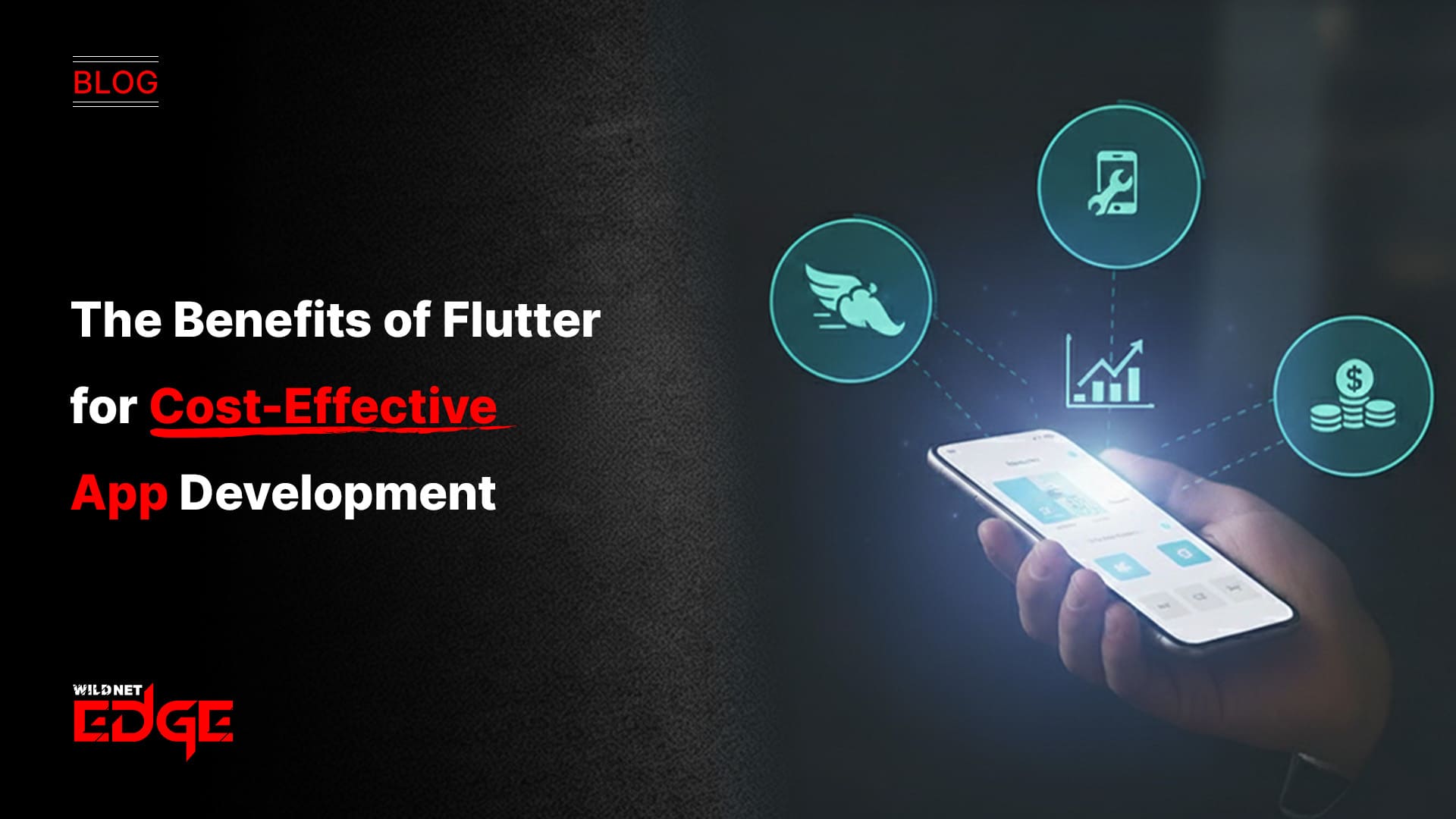TL;DR
This article details why Flutter is a leading choice for creating flutter cost-effective apps. It explains how the framework’s single codebase enables simultaneous development for iOS and Android, delivering significant cross-platform savings. Key Flutter advantages, like Hot Reload, accelerate development time, reducing labour costs. The piece contrasts Flutter with native development, highlighting its ability to produce high-performance apps with a unified UI while simplifying long-term maintenance. For businesses seeking an efficient path to market without compromising quality, Flutter is presented as a strategic and budget-friendly solution.
Launching a mobile app is a powerful way to connect with customers. Still, the development costs, especially when targeting iOS and Android, can be daunting for businesses of all sizes. The traditional approach of building two separate native apps requires double the effort, double the team size, and often double the budget. Fortunately, modern technology offers a smarter path. Flutter, Google’s UI toolkit, has emerged as a leading solution for building high-quality, flutter cost-effective apps without breaking the bank.
What is Flutter?
Flutter is an open-source framework that allows developers to build beautiful, natively compiled mobile (iOS & Android), web, and desktop applications from a single codebase. It uses the Dart programming language and a widget-based architecture that provides rich, pre-built, customizable UI widgets. Unlike some older cross-platform solutions, Flutter applications offer excellent performance and a truly native feel, making them a powerful choice for businesses that need quality on a budget.
Why Flutter is The Most Cost-Effective Path to High-Performance App Development
Several core Flutter advantages make it uniquely suited for businesses looking to maximize their development ROI.
The Power of a Single Codebase: Massive Cross-Platform Savings
This is the single biggest reason of cost reduction. With Flutter, your development team writes code once, and it compiles to run natively on both iOS and Android. Consider the traditional native approach: you need an iOS team (writing Swift) and an Android team (writing Kotlin), effectively doubling your development headcount and project timeline.
Flutter eliminates this duplication. A single Flutter team can build and maintain both versions of your app. This consolidation leads to dramatic cross-platform savings, often reducing overall development costs by 30-50% compared to building two separate native apps. This efficiency is why many businesses seek out a specialized Flutter App Development Company.
Accelerated Development with Hot Reload
Flutter’s “Hot Reload” feature is a significant time-saver. It allows developers to see the effect of code changes in the running app almost instantly (often in under a second). This rapid feedback loop dramatically speeds up UI development, bug fixing, and experimentation. Faster development cycles mean fewer billable hours and a quicker time-to-market for your application. This rapid iteration capability is one of the key Flutter advantages.
Reduced Testing Effort
Quality assurance is a critical but time-consuming part of app development. With separate native apps, your QA team needs to test two distinct codebases across a wide range of devices for each platform. Because Flutter shares the majority of the code, the testing effort is significantly reduced. While platform-specific testing is still necessary, the bulk of the business logic and UI testing only needs to happen once, leading to further cross-platform savings.
Lower Long-Term Maintenance Costs
Launching the app is just the beginning. Ongoing maintenance fixing bugs, adding features, supporting new OS versions is a significant long-term cost. With a single Flutter codebase, this process is vastly simplified. You update the code once, and the changes apply to both iOS and Android. This reduces the long-term cost of ownership compared to maintaining two separate native applications.
Flutter vs. Native: A Cost Perspective
While native apps offer the absolute peak performance, Flutter provides near-native performance at a significantly lower cost, making it ideal for most business applications.
| Factor | Flutter Development | Native (iOS + Android) |
| Development Team Size | Smaller (One team) | Larger (Two teams or double time) |
| Codebase | Single | Two Separate |
| Development Time | Faster | Slower |
| Testing Effort | Reduced | Doubled |
| Maintenance Cost | Lower | Higher |
| Overall Cost | Significantly Lower | Significantly Higher |
Building Flutter Cost-Effective Apps: Real-World Examples
The theory is compelling, but how does it play out in practice?
Case Study 1: A Startup’s MVP Launch
- The Challenge: A bootstrapped startup needed to launch a Minimum Viable Product (MVP) on both iOS and Android to validate its business idea, but it had an extremely limited budget. Native development was prohibitively expensive.
- Our Solution: We recommended Flutter as the ideal technology. Our team built a polished, functional MVP using a single codebase, leveraging Flutter’s rich widget library for a fast UI build. This showcased the power of flutter cost-effective apps.
- The Result: The startup launched on both app stores simultaneously in just under four months, at nearly half the projected cost of native development. The high-quality MVP helped them gain early traction and secure seed funding.
Case Study 2: An Enterprise’s Internal Tool
- The Challenge: A large corporation needed an internal mobile app for employees across various departments, using both iPhones and company-issued Android devices. Consistency and ease of maintenance were key priorities, alongside budget control.
- Our Solution: We opted for Flutter to ensure a perfectly consistent UI and user experience across all devices. The single codebase simplified the integration with their existing backend systems and made future updates straightforward for their internal IT team. This strategy is common for a Cross Platform App Development Company.
- The Result: The app was rolled out successfully, and the unified codebase significantly reduced the long-term maintenance burden for their IT department. The project was delivered 30% under the initial budget allocated for potential native development.
Our Technology Stack for Flutter Development
We use a modern stack focused on efficiency and quality.
- Language: Dart
- Core Framework: Flutter
- State Management: BLoC, Provider, Riverpod
- IDE: Android Studio, VS Code
- CI/CD: Codemagic, Bitrise
- Backend: Firebase, Supabase, Custom APIs (Node.js, Python, etc.)
Conclusion
In the search for efficient and impactful mobile solutions, Flutter stands out as a strategic choice, particularly when building flutter cost-effective apps. Its ability to deliver high-quality, near-native experiences on both iOS and Android from a single codebase provides undeniable cross-platform savings and accelerates time-to-market. These core Flutter advantages make it an ideal technology for startups and established businesses alike looking to maximize their development ROI.
Ready to leverage Flutter for your next project? At Wildnet Edge, our AI-first approach enhances our Mobile App Development Services, allowing us to build intelligent, data-driven applications efficiently. Partner with us to build a high-performance app that fits your budget and exceeds your expectations.
FAQs
For most business applications, users will not notice a difference in performance. Flutter compiles to native code and uses the GPU directly, resulting in smooth animations and fast load times. Only extremely graphics-intensive 3D games might see a slight edge with native.
Yes. Flutter has a stronger mechanism called “platform channels, ” allowing your Flutter app to communicate with platform-specific native code (Swift/Objective-C for iOS, Kotlin/Java for Android). This provides flexibility if you need to access a specific or new native feature.
For developers familiar with object-oriented programming (like Java or C#), learning Dart (Flutter’s language) is relatively straightforward. Developers with experience in reactive frameworks like React will also find Flutter’s concepts familiar. The large community provides excellent learning resources.
Flutter itself is open-source and free. The primary costs are developer time. Compared to native development, there are generally fewer “hidden” costs because you manage one primary codebase instead of two. Cloud hosting and third-party service costs are similar regardless of the framework.
QA testing is a significant portion of any app development budget. Having a single codebase for the core application logic and UI means your QA team can focus the bulk of their automated and manual testing efforts once, rather than repeating the entire process for two separate native apps, delivering significant cross-platform savings.
Flutter has excellent support for accessing native device features through a rich ecosystem of official and community-developed plugins. Accessing standard hardware like cameras, GPS, sensors, and Bluetooth is straightforward.
The choice often depends on specific project needs and team expertise. Flutter generally offers potentially better performance out of the box and more control over the UI, while React Native leverages the vast JavaScript ecosystem. An experienced development partner can help you evaluate the tradeoffs for your specific situation.

Nitin Agarwal is a veteran in custom software development. He is fascinated by how software can turn ideas into real-world solutions. With extensive experience designing scalable and efficient systems, he focuses on creating software that delivers tangible results. Nitin enjoys exploring emerging technologies, taking on challenging projects, and mentoring teams to bring ideas to life. He believes that good software is not just about code; it’s about understanding problems and creating value for users. For him, great software combines thoughtful design, clever engineering, and a clear understanding of the problems it’s meant to solve.
 sales@wildnetedge.com
sales@wildnetedge.com +1 (212) 901 8616
+1 (212) 901 8616 +1 (437) 225-7733
+1 (437) 225-7733































